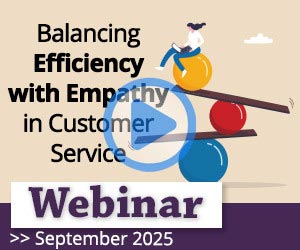We investigate how to successfully say “no” to a customer in the contact centre.
1. Demonstrate that Everyone Is on the Same Side
From the beginning of the call, create the impression that the customer is in safe hands. Doing so allows advisors to build rapport. When this happens, customers are more likely to accept the potential “no”.
Use statements such as: “I can understand why this is troubling you. It is not a situation that we would like any of our customers to experience. Let me see what I can do for you today.”
By using language like this, the advisor demonstrates to the customer that they care about them. If they were to instead say “no” to the customer’s demand, right from the get-go, an uncomfortable stand-off situation will likely ensue.
So, frame the conversation using positive, empathetic language and try to find an alternative solution, rather than delivering bad news right away.
2. Uncover an Alternative Solution
To offer a first-rate alternative solution and avoid only saying “no”, it is critical to maintain a positive mindset and empower advisors.
Mindsets Make a Difference
Mindsets drive advisors to say “no”, despite viable solutions often being available.
Thoughts such as “customers are difficult”, “customers push the boundaries”, or “customers always want a freebie”, begin to pollute an advisor’s mind after a succession of calls.
Such patterns are dangerous because it is easy for the mind to refer back to previous customer interactions and introduce bias, according to Lee Jones, director at Elev-8 Performance.

“High-performing advisors are, typically, those who can hit the ‘reset button’ after the call,” he says. “They don’t take the baggage from previous calls into their next interaction.”
It is crucial to stay buoyant, present and curious. If not, it becomes easy to start making assumptions. Then, advisors misdiagnose the issue and say “no”, despite other solutions perhaps being available.
To put this right, coach the importance of avoiding assumptions.
3. Reflective Listening
Reflect queries back to the customer and ask: is that right? If it is not, the advisor can clarify the issue. If it is, the customer knows their problem and demand is fully understood. With everyone on the same page, customers will more likely accept “no” as an answer.
4. Positive Thinking
If advisors are staring at the clock, counting down the minutes until the end of their shifts, that does not bode well for customer service.
Remind advisors of the value of each call to the customer and drive accountability. Frequent informal interventions will help, encouraging advisors to think positively and find new solutions.
With the right mindset and a full understanding of the customer issue – as well as what they want – the advisor is better placed to find an excellent alternative solution.
5. Trust Advisors to Uncover New Solutions
Empower advisors to find new, intelligent solutions instead of deferring to “no”.
Such advice complements customer service but is very tricky to implement. After all, contact centres have black-and-white processes for a reason. If everyone sidesteps them, mayhem ensues.
Yet, if there is a grey area, with no clear guidance in the knowledge system, encourage advisors to give themselves space to think through the matter.
6. Check All the Possible Options
Instead of saying “no”, ask the customer: “I need a moment to check all the possible options. Could I give you a callback in five minutes?”
Advisors then have the time to weigh up their options, ask a colleague or subject-matter expert (SME) for their thoughts, and act.
Such a system requires trust, especially if contact centres take it to the next level and encourage advisors to go beyond the grey areas.
As an example, consider a scenario where a loyal, high-value customer asks for support that goes against the traditional process. In such a scenario, empower advisors to give themselves the space to consider the consequences of making an exception for this customer.
Allow them to explain the exceptional circumstance to a manager or SME. Then, as a team, consider if making an exception is better than potentially losing the customer.
Of course, many might worry about how this approach impacts handling times. Yet awkward stand-offs where advisors say “no” often escalate into long, uncomfortable conversations regardless.
Discover more of the fundamentals of contact centre empowerment by reading our article: It’s Not Empowerment Unless You Trust People
7. Give a Clear-Cut Reason for the “No”
Even with a first-rate alternative solution, the advisor must still tell the customer that they cannot deliver what they demand.
Therefore, the advisor must give a concise explanation of why their answer is “no”. If they do so, the customer is much more likely to accept the outcome.
The key is to get straight to the point. It is easy to expect confrontation when saying “no”. Adrenaline then kicks in as advisors experience the urge to add preamble, fluff and excessive apologies to their explanation.
However, be assertive when delivering bad news. Myra Golden, a customer service expert, believes that this is the silver bullet.
“Say what you mean. Mean what you say. Don’t be mean when you say it,” she recommends.
In this sense, advisors must manage their emotions. Coach them to be intentional about feeling and sounding confident. Speaking from the diaphragm, keeping their explanation concise and using statements, not questions, will enable an advisor to do this.
In terms of word selection, Jeffrey Victor, founder of Luminary Learning Company, suggests that advisors refrain from using the words:
- “Unfortunately” – Such a word shuts down the conversation. It indicates that something unpleasant is going to happen, which evokes ill-feelings from the customer.
- “I’m afraid” – Again, this language triggers intense, negative emotion.
- “At least” – Terms of this nature drive disconnections with the customer. It is sympathy, not empathy, which contradicts good rapport.
Instead, he recommends a simple statement such as: “At this time, that is not possible because… Here is what we would like to do instead…”
Using this language allows the advisor to avoid fixating on the negative and driving customers to a place of dissatisfaction. Instead, they can quickly shift the focus on the solution.
8. Acknowledge, Empathize and Apologize
After proposing the alternative solution, manage the customer’s emotional response. A simple statement which acknowledges the impact of the predicament ensures that the customer feels heard. It may also pre-empt an escalation.
Paired with an empathetic tone for sincerity, consider the following helpful statements:
- “I appreciate that this situation has put you in a bind. It can’t have been easy. Yet, this solution…”
- “I realize that this situation has thrown off your day. It is a real shame that this has happened. To put it right, our solution…”
Again, these statements refocus the customer on the possible solution, positively framing the rest of the conversation around what the advisor can do. The focus then shifts to realistic outcomes, bypassing any further disappointment.
But if the company was very much in the wrong, add an apology before refocusing the conversation. In these instances, doing so is an integral part of delivering bad news.
Research available in the US National Library of Medicine even highlights that: “There is evidence that apologies tend to diminish blame and make injured patients less likely to sue and more willing to settle when they do.”
Such a study demonstrates the value of a simple, sincere apology statement. To get this right, coach advisors to be specific in their apologies and avoid generic phrases such as: “I am sorry for any inconvenience”.
Coach your team how to deliver meaningful apologies with the help of the following article: Customer Service Apologies – Keeping Sorry Fresh and Sincere
9. Offer the Customer a Chance to Respond
After moving through the previous steps, stop and give the customer a chance to respond. Pausing for just three or four seconds prevents the advisor from over-explaining and losing their air of confidence.
Also, customers can then take the time to express their emotions and ask questions.
If a customer does express emotion, go back to acknowledgement and empathy before once again promoting the solution that is now available to them.
Hopefully, the customer will opt for the proposed solution or – alternatively – back down. If they continue to drag their heels after continuous acknowledgement and empathy, however, it is time to consider last resorts.
Last Resorts

No matter how methodically advisors handle these conversations, a select few customers will never accept “no” as an answer. Occasionally, they will even push back when the advisor provides a thoughtful alternative solution.
In these scenarios, Lee Jones encourages advisors to: “Never give in, suggest an escalation or offer care credit. Be strong. Customers of this nature will seize on any such cracks in the call handling approach of an advisor.”
Avoid statements such as: “I’m sorry, but that is all I can do,” as they will only serve to aggravate the customer.
Instead say: “I’ve given you your options, which would you like to go for?”, or: “Would you like me to go back through the options or would you like to go away and have a think about them?”
The last example can prove particularly powerful. It is definitive, negates negative language and passes the power over to the customer. They then gain the sense of control that they crave.
If the customer continues, assure them that the options will not change, no matter who they speak to, and refer to the policy.
Consider a statement such as: “Using our policies as a reference, I have given you the options that we – as a business – can offer you.”
If the customer then asks to speak to a manager, stay confident and assured. Tell them: “They will give you the same answer that I’ve given you.”
Yet this comes with a warning. Avoid saying: “It’s company policy,” especially when it is early in the conversation. Doing so will appear evasive and will stir up ill-feeling on the part of the customer.
After each of these stages, Jeffrey Victor concludes that all the advisor can do is stay true to their brand.
He recommends using the customer’s first name and saying:
“[FIRST NAME], this is what we believe is the best solution for you. We stand behind the product and services that we have delivered to you today.”
10. Finally… Create a Strategic Resolution Plan
Take the steps above and create a simple process for advisors to follow. Often, this is known as a “strategic resolution plan”. Such a plan ensures that advisors are confident in handling these tricky situations.
Role-playing this through is a great idea. Also, enhance the plan with a list of potential solutions which have proven successful when dealing with common objections.
With empowerment, advisors may then choose the solution that is most appropriate to the customer’s situation. Doing so will help to smooth over grey areas within contact centre processes.
Finally, find call recording examples of when advisors successfully say “no” to the customer while adhering to the plan. Playing these back to groups of advisors may become an invaluable coaching tool.
Dealing with difficult customer scenarios like this is never easy. Yet we have got your back. The following articles all provide advice for handling more types of tricky customer contacts:
- How to Deal With a Customer Who Can’t Stop Talking
- How to Handle Call Escalations
- How to Handle an Angry Customer
Author: Robyn Coppell
Reviewed by: Hannah Swankie
Published On: 31st Aug 2022 - Last modified: 21st Oct 2025
Read more about - Customer Service Strategy, Angry Customers, Call Handling, Customer Engagement, Customer Management, Customer Service, Editor's Picks, Service Strategy, Soft Skills











































